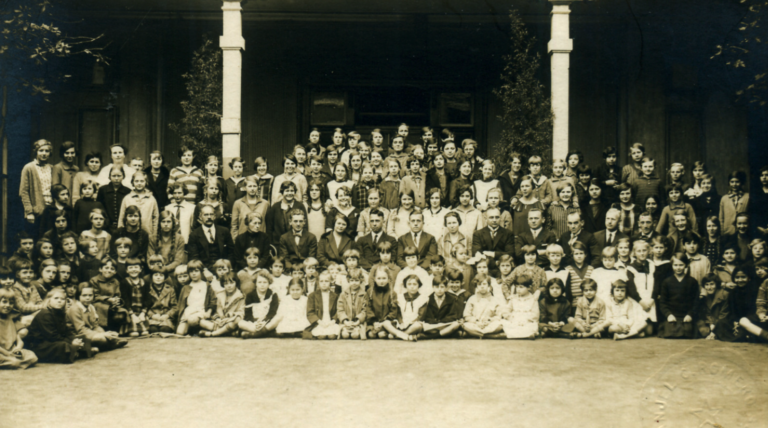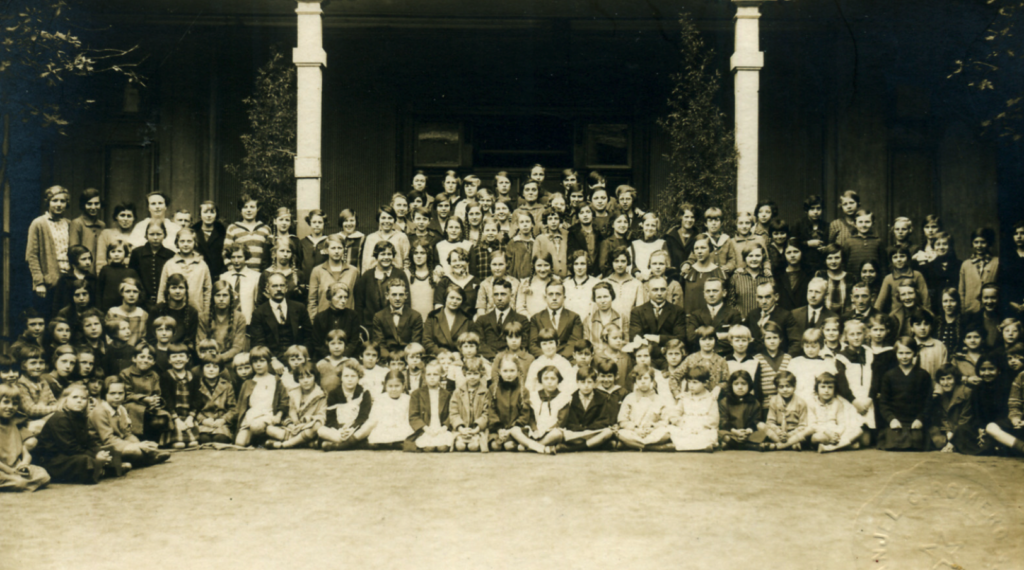Go-Betweens
A Miniseries on Youth, Migration, and Knowledge Transfer
With contributions by Simone Lässig, H. Glenn Penny, Elisabeth Engel, Brian Van Wyck, and Swen Steinberg.
I have spent a lot of time thinking about German children who migrated to Latin America during the late nineteenth and early twentieth centuries. I would like to suggest that the history of these children in states such as Chile has something to teach us about migrant knowledge that is often overlooked by the fabulous work being done on young migrants to Europe or the United States.1 In part, this neglect occurs because much of the work turns on children arriving in cities such as Chicago or Frankfurt, where, due largely to the state-organized school systems, they integrated more quickly than their parents into the host culture and language. Along with those children’s rapid knowledge acquisitions was often a great deal of cultural, intellectual, and social capital, which could literally transform migrant children into crucial go-betweens who, in some cases, offered their families great advantages. As a number of scholars have demonstrated, that could also upend power relationships within families.2
If that model works well in some specific moments of migration to Europe and the United States, it is not as useful for understanding what happens when German families migrate to much of Latin America. I am also concerned about its usefulness when we shift our perspective from specific historical moments to dialogical relations across time. I would like to address each of these points in turn.
German Migrants in Chile
The contexts of migration from Germany to Chile between the 1850s and the 1950s were much different than from Africa to France or from Europe to the United States during this period. Most importantly, the Chilean state and its elites coveted the many forms of knowledge German migrants brought with them. In many ways, those knowledge forms were purposeful imports. State officials and local elites also regarded the schools that German communities quickly established in port cities, rural towns, villages, and the capital of Santiago as model educational centers. Many Chilean elites, in fact, sent their children to those schools right through the interwar period. Moreover, while the Chilean state not only actively encouraged the creation of these schools and lent them some financial support, it also demanded that they include some non-German Chileans among their students, so they could glean from the imported knowledge. To extend that benefit, the state also modeled its own schools on these German schools, and it actively recruited German teachers to staff them. It also hired German pedagogues to build a pedagogical institute at the Santiago University to train Chilean teachers.3
So, rather than the children of German migrants to Chile gaining far greater access to cultural and intellectual capital through schools established by the host society, as they might have in the United States, those children attended schools created by their parents and other German migrants to ensure that the cultural and intellectual capital they brought with them would be passed on to the migrant children and their grandchildren.
Migrant children, however, did not simply receive knowledge. Within the German schools, and as German migrant children matured and left them, those children acted as knowledge producers, helping to combine local knowledge and what Simone Lässig and Swen Steinberg have termed “migrated knowledge” in the classrooms and streets.
At the same time, the many non-German children who attended the schools came from local families who hoped to use their children as the go-betweens we have come to expect in these situations. Yet in this case, the children of local elites were the agents assigned to gaining some of the cultural, financial, intellectual, social, and ultimately political capital that came with their exposure to the “migrated knowledge” of German children and the German schools.4
This inverts the story we are accustomed to reading about non-European children arriving in Central Europe or various non-anglophones arriving in the United States. At the outset of the twentieth century, when much of Spanish-speaking Chile was illiterate but almost none of the German migrants were, those migrants arrived with a decided advantage rather than a set of distinct disadvantages. Moreover, they also arrived with other kinds of knowledge that was associated with ties to German shipping companies, financial and trade networks, and hosts of pedagogical institutions from grade schools to elite research universities and trade schools. Consequently, advantages were not located in the quick integration of German migrant children into Chilean culture, society, and its institutions but in German migrants’ assurance that their progeny would be able to harness and preserve the knowledge that migrated with them and that this younger generation would continue to tap the conduits of knowledge that formed as that integration took place.

Narrating the Dialogic
While that inverted story of German migrants, migrant schools, and migrating knowledge in Chile is instructive, it also has some serious limitations. It relies on unitary terms such as “Chilean,” “German,” “children,” and “knowledge.” Yet none of these categories has proven hard and fast over time. Consequently, our reliance on them makes it difficult to narrate the history of the processes at work and the roles of the actors, who are often moving targets. After all, childhood is a temporary phase. And within these German-Chilean communities, the children of German migrants became Chileans while attending the German schools. Moreover, if some began their time in these schools as the carriers of “migrated knowledge,” they, not to mention their children or grandchildren, became the local residents who encountered or confronted new influxes of migrant knowledge over subsequent decades along with the non-German children in the schools.
These dialogical relations are difficult to narrate: As people continued over decades to migrate from an ever-changing Germany, with its shifting borders and regimes, to an ever-changing Chile (which at least had consistent borders), knowledge continued across the interwar period to migrate with German children into these schools. At the same time, however, it also came with the teachers from Germany, who were often young, unmarried, and , especially by the 1920s, were overwhelmingly visitors who stayed for only three to five-year sabbaticals. These teacher rotations not only brought with them the fruits of ever-shifting pedagogical training and expanding empirical knowledge in Germany but also the shifting cultural codes and mores of young, urban Germans from the roaring twenties, not to mention sometimes disconcerting political positions. Their attitudes often delighted the pupils as much as they unsettled the parents. Gender relations, for example, “modernized” at a different pace in the middle-class merchant communities of Concepcion and Valdivia than in Berlin or Hamburg. Moreover, after the National Socialists came to power in Germany, the German Foreign Office only sent teachers who were party members to work in German schools abroad.
In addition, while knowledge kept migrating with new waves of young students and teachers into these schools, it arrived as well with new books, films, images, maps, and a wide spectrum of material culture ranging from paint brushes and fountain pens to textbooks and chemistry sets, not to mention literature and plays.5 How the evolving groups of schoolchildren performed Germanness in the hallways and classrooms, on the streets, and in the school productions of Faust, William Tell, and other plays also changed over time as the new waves of knowledge flowed into the schools, with new teachers and new performcae models integrating with the equally fluid cultural codes and local forms of knowledge in Chile.
Even the hyphenated marker German-Chilean, while useful as a descriptive category, works poorly as an analytical one. As the leading pedagogues of German schools in Latin American knew all too well, the thirty or more German schools extant in Chile during the interwar period ranged from primary schools to the elite institutions that prepared students for university studies anywhere in the world. The schools also served very different German-Chilean communities. Life in rural locations in southern Chile moved at a different pace than in the merchant-dominated port cities or the capital of Santiago. There were different mixes of students as well.
One commonality among all the schools was their support by the German and non-German families that sought the best education for their children, but the kinds of education the families wanted and the dynamics of their encounters in the schools differed with location and need. In Valdivia, where the over 450 students attending its German school in 1903 came from German colonists and in some cases were already second or third-generation German-Chileans, the confrontation with imported knowledge was less complex and not so unlike what one might encounter in Imperial Germany as new generations introduced ideas into schools. In part, that was also because so many of the families shared similar outlooks—similar economic interests, desires, goals, with little competition from non-Germans.
That was not the case in Valparaiso or Santiago, where by the 1920s as much Spanish as German was spoken in their schools, and where the student bodies were more mixed than in the ports and the rural districts further south. In all of these locations, examinations were similar, organized by the leadership of the league of German-Chilean teachers. That meant that preparations for higher exams was also similar as well. If students in 1928 Concepcion wrote in their qualifying exams in German on the rise of the British Empire during the preceding years and in Spanish on the expansion of the railroad system in Chile, their counterparts in other locations would have written on similar topics as well. Yet in each case, the school boards were drawn from the local communities, and those influenced things such as foreign language choices—English was imperative for merchants’ children in the ports, but not for farming in the rural south.
When the German pedagogue Robert Gabert attempted to make sense of such similarities and differences in Argentina, which had about ten times as many German schools as Chile during the interwar period, he stressed that any attempt to create a common curriculum for German-Argentine schools would shatter on the fact that these schools must by virtue of their varied communities contain many differences. It was not so much that Germans in Argentina or Chile had quickly taken up citizenship and recognized that their children, born into citizenship, must be raised to become Argentinean or Chilean. That was true. But they also lived in particular locations, and Gabert recognized that every German school outside of the German nation-state must by necessity have a slightly different lesson plan, one that fit the local needs of their communities as well as the aspirations of the children’s parents. Moreover, he recognized that those needs were always in flux, always shifting over time.6
That fluidity vexed many of his colleagues who hoped to develop consistent study plans and examinations across all the German schools in Argentina and even across Latin America. Gabert recognized, however, that their goals were as unobtainable as they were unwarranted because life for these children and their families took shape in local contexts. Thus, for example, the gender norms and modes of comportment between female and male teachers newly arrived from Germany in a place like Valdivia during the 1920s, which so titillated the school’s children and upset their parents, were hardly new in a city like Santiago.
What constituted newly migrated knowledge could vary across space and time, even in communities and schools as well integrated as those in Chile. At the same time, the children who might one year carry with them migrated knowledge and help to channel and shape it during their encounters with others might very well transform into residents who, as older children or adults, were on the receiving end of such knowledge transfer and production.
This simultaneity of fluidity and stasis is challenging to narrate. There is no question that the schools and the children within them shaped chain migration and helped these communities as well as the individual families stay together. It is also clear that the children of non-German Chileans who attended the schools became a way for migrant knowledge from Central Europe to enter those Chilean homes, almost the reverse of the North American strategy of using children in schools to deliver books, language, and knowledge into immigrant homes. This is, I think, another example of the kind of multidirectional agency of migrant children we now expect, but with a bit of a twist. I wonder how far we can twist it.

H. Glenn Penny is Professor of History at the University of Iowa. He is currently completing Unbinding German History, 1760s to the Present for Cambridge University Press. He is not on Facebook and does not do Twitter, but h-penny@uiowa.edu works.
- For an excellent overview, see Simone Lässig and Swen Steinberg, eds., “Knowledge and Young Migrants,” special issue, KNOW: A Journal on the Formation of Knowledge 3, no. 2 (Fall 2019): 195–350. ↩︎
- For example: Sarah E. Chinn, Inventing Modern Adolescence: The Children of Immigrants in Turn-of-the-Century America (New Brunswick, NJ: Rutgers University Press, 2009); Paula S. Fass, Outside In: Minorities and the Transformation of American Education (Oxford: Oxford University Press, 1989); Brittany Lehman, Teaching Migrant Children in West Germany and Europe, 1949–1992 (New York: Palgrave, 2019); and Kristine Mouruzi et al., eds., Children’s Voices from the Past: New Historical and Interdisciplinary Perspectives (New York: Palgrave, 2019). ↩︎
- For example: Cristina Alarcón, El discurso pedagógico fundacional de docentes secundarios. Sobre la transferencia educativa alemana en Chile (1889–1910) (Buenos Aires: Libros Libres, 2010); and Carlos Sanhueza-Cerda, “La gestación del Instituto Pedagógico de Santiago y la movilidad del saber germano a Chile a finales del siglo XIX,” Estudos Iberoamericanos 39, no. 1 (2013): 54–81. ↩︎
- For a broader discussion, see H. Glenn Penny, “Diversity, Inclusivity, and Germanness in Latin America during the Interwar Period,” Bulletin of the German Historical Institute Washington DC 61 (Fall 2017): 85–108. ↩︎
- For more discussion of material culture, see H. Glenn Penny, “Material Connections: German Schools, Things, and Soft Power in Argentina and Chile from the 1880s through the Interwar Period,” Comparative Studies in Society and History 59, no. 3 (2017): 519–49. ↩︎
- Reinhold Gabert, Das deutsche Bildungswesen in Argentinien und seine Organisation (PhD diss., Erlangen University, 1908). ↩︎





